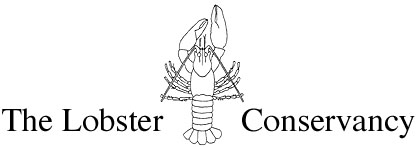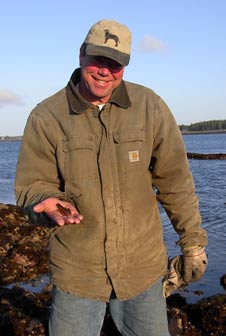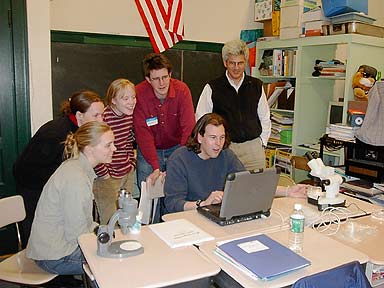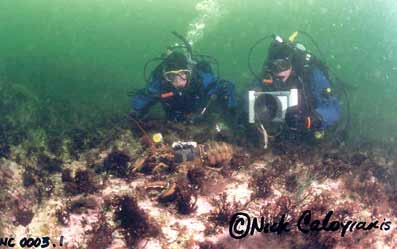
P.O. Box 235, Friendship, ME 04547 (207) 832-8224 www.lobsters.org

P.O. Box 235, Friendship, ME 04547 (207) 832-8224 www.lobsters.org
June 2003
Dear Volunteers and Friends of The Lobster Conservancy,
The Lobster Conservancy's mission is to sustain a thriving lobster fishery through science and community. This newsletter keeps our friends and volunteer research team informed of our activities. Here's what we've been up to over the past few months.
News from the Board of Directors
Welcome TLC's Summer Intern
Sarah Havener of Friendship is a summer intern with TLC this summer. Sarah, who just completed her freshman year at the University of New Hampshire, will be involved in all our ongoing projects, including sonar tracking, juvenile lobster monitoring, lobster behavior work at the pound, and education. When Sarah isn’t working at TLC this summer, she will be sternman on her father Mark’s lobster boat, as she has for many summers.
Research News
Juvenile Lobster Project
Preliminary results from 2002
In 2002, 65 volunteers and 5 TLC scientists participated in the Juvenile Lobster Monitoring Program (JLMP), monitoring 24 sites (19 sites in Maine, 2 in New Hampshire, and 3 in Massachusetts). Here we report on only 22 sites, since the year-round data collected at Friendship Long Island and Lowell's Cove are currently being analyzed separately. Volunteers captured 1,169 lobsters, whose carapace length (CL) ranged from 4 mm to 85 mm. Mean carapace length was 33.3 mm. All lobsters but one were below minimum legal size (83 mm CL).
Recently settled lobsters (i.e., <10 mm CL) were detected at 16 out of 22 sites. First-years lobsters (<17 mm CL) were detected at 19 of 22 sites, i.e., all but Lanes Island, Drift Inn Beach, and Odiorne Point. The mean density of all lobsters at each site ranged from 0.09 to 1.14 lobsters/m2. Mean density of first year lobsters ranged from 0.0 to 0.39 lobsters/m2. The sites with the five highest densities of first-year lobsters were Little Harbor, Potts Point, Back Shore of Round Pond, Cundy's Harbor, and Pratt Island (Figure 1), three of which are located in Casco Bay.

Looked at as a whole over the last 3 years, lobster settlement, as indicated by mean density of first year lobsters, was highest in 2002 (Figure 2).

On closer inspection, we found that this pattern of greatest settlement in 2002 was not true for all regions. Maine's Casco Bay is the only region where we have a sufficiently long time series to look for a trend. In Casco Bay, there was indeed an upward trend in settlement over time. In other regions, our data sets are too short to look for such trends, but we can make the following observations. At our 3 sites in Penobscot Bay, settlement was not detected in 2002, nor in 2000. In Midcoast Maine, settlement was greater in 2001 and 2002 than in 1999 or 2000. In New Hampshire, density of first-year lobsters was highest in 2002. And at our 3 sites in Massachusetts, first-years were less abundant in 2002 than in 2001. Continued long-term monitoring in these regions will allow us to look for trends over time. (More results are detailed in our preliminary report to Maine Department of Marine Resources).
JLMP in 2003
We are busily in the midst of our 8th year of volunteer-based sampling in the JLMP. Season Kick-Off meetings were held on a snowy April 5th in Portsmouth, New Hampshire and April 6th in Friendship, Maine to update volunteers. Thank you to the NH Urban Forestry Center in Portsmouth and the Hahn Community Center in Friendship for providing space for these events. At the meetings we discussed the results of the 2002 sampling season and the 2002 Volunteer Evaluation Questionnaire, and reviewed improvements in procedures for this year. We also premiered our online data entry system.
This year, more than 70 volunteers are monitoring juvenile lobsters at 24 established sites from Nahant, MA to Winter Harbor, ME. Welcome aboard to new volunteers Enid Johnson and Seth Barker (Pratt Island, Southport), Anna Ponziani (not really new, but now officially part of mom Corie Bibber-Logan’s Bailey Island team), Brook Vail and Margaret Stone (Lowell's Cove, Orr's Island), Sue Lamdin (Potts Point, South Harpswell), Rich Filmore (Zeb Cove, Cape Elizabeth), Pat Makin (Plum Cove, Gloucester), Gillian and Gene Cornfield, Erin Weber (Gerry Island, Marblehead). Most teams began sampling in April during the spring low tides and will continue their monthly surveys through November. We have conducted training for new volunteers at Potts Point, Pratt Island, and Gerry Island. Special thanks to Jess Munro for helping Linda Archambault on Allen Island in May and to Stacy Welner and Sheri Hawkes for sampling with Jane Roundy in May at two sites in Harpswell where the regular teams were unavailable.
Most of the hardy teams that sampled in the freezing cold in April did not find any lobsters. The exceptions were Gerry Island (8 lobsters measuring 10 to 41 mm CL), Pratt Island (5 lobsters 13 to 31 mm CL), and Goose Rocks Beach (13 lobsters 11 to 44 mm CL). Thanks to all who braved the April cold. Fortunately, May was considerably warmer and volunteers at most sites were rewarded by finding at least one lobster. The most productive nursery sites were Little Harbor (9 lobsters, 18 to 44 mm CL), Pratt Island (10 lobsters, 7 to 53 mm CL), Back Shore Road (11 lobsters, 15 to 51 mm CL), Plum Cove (28 lobsters, 5 to 60 mm CL), and Gerry Island (35 lobsters, 9 to 83 mm CL).
One thing that some volunteers discovered on their first sampling of the year was that winter had brought significant changes to their sites. Two of our volunteer sites in Penobscot Bay, Waterman Point and Drift Inn Beach, experienced significant silting over the winter. At the traditional transects, almost all flippable rock habitat had become buried. Several sites further south, including Diane’s long-term site at Lowells Cove, have also seen a significant portion of their transects impacted by silting. This was the first winter since the Juvenile Lobster Monitoring Program began 11 years ago that brought such major changes to the shoreline. Winter storms and ice moved rocks and sand, causing reconfiguration of many of the lobster transects. As a result, some volunteers have had to modify their sampling location slightly.
One of goals for the JLMP in 2003 is to add some new sites. Last year, the Lobster Advisory Council of the Maine Department of Marine Resources awarded TLC a small grant to expand the JLMP into all seven of Maine’s lobster management zones. We were already in four zones (C, D, E and F) so we needed to add sites in zones A, B and G. In Zone B, Diane and Sara scouted for a new site in Winter Harbor last fall, and trained new volunteers Thomas Mayer and Jeannie Wilson. On Little Cranberry Island (also Zone B), Island Institute Fellow Jesse Minor recruited volunteers who helped him scout for potential monitoring sites in April. In May, Diane and Sara gave a public presentation hosted by the Island Institute as part of their Fellows Retreat. Over the following two days they scouted for sites with help from Rick and Stefanie Alley, Cindy Thomas, Sam Hyler, and Fellows Dan O’Grady, Jesse Minor and Leah McDonald. On the last day--at the last minute--Rick found one little lobster (23 mm CL), which made us believe we’ll find a good monitoring site on Little Cranberry in June.

Lobsterman and JLMP volunteer Rick Alley finds the first intertidal lobster on Little Cranberry Island. (Photo by Sara Ellis)
In Zone G, Sara scouted for sites last fall with help from Dawn Morse, an AmeriCorps volunteer who works at Laudholm Farm. We scouted at Wells Beach, Laudholm Beach, and Drakes Island, but didn’t find any lobsters or appropriate habitat. In April, we found a rich lobster nursery at Timber Point in Biddeford, just off Goose Rocks Beach. In May, Sara trained volunteers Patrice Farrey, Dave McCarron, and Herb and Judy Cohen to monitor at Timber Point. Sara will be scouting for sites in Zone A in June and July.
Thanks to Sean and Laura Creagan of db-ology Inc., our on-line database application went live in April in time for teams with internet access to enter their data remotely online. Volunteers are now able to input their data and to use the web to review data from their monitoring site over the years as well as view graphs from other sites. The feedback from almost everyone who has entered their data has been extremely positive and volunteers love the information now available at their fingertips. Our goal is to have the data from all sites input and proofread each month before the next monthly sampling sessions begin. Thank you to the National Fish and Wildlife Foundation, King and Jean Cummings Trust of the Maine Community Foundation, and Bruce J. Anderson Foundation of the Boston Foundation, and New England Biolabs for providing funding for our on-line database application.
Outreach and Education
Lobster Curriculum Retreat

Island Institute Fellow Dan O'Grady wows the crowd with images from a digital microscope at the Lobster Literacy Retreat, held in Rockland and Friendship, April 12 & 13. (Photo by Sara Ellis)
On April 12 and 13, TLC and the Island Institute hosted a Lobster Literacy Retreat. Participants included 8 Maine teachers and 5 Island Institute fellows. On the first morning, participants were treated to three presentations: TLC’s senior scientist Diane F. Cowan, on the lobster life cycle, Sarah Gladu of University of Maine/Maine Sea Grant on marine plankton, and Cathy Billings of Lobster Institute on their oral history project. Saturday afternoon was spent in the Friendship Village School classroom of Carla Eutsler, where TLC educators Linda Archambault and Dan O’Grady instructed teachers on the specifics of the Lobster Larvae in the Classroom project. Michael Ashmore, Director of Instruction in MSAD #40, led the next day's session. A group brainstorming session produced many ideas for lobster-related lessons to be used by teachers in grades 5-8. Michael Ashmore presented a talk on recent research on teaching strategies. Before the meeting adjourned, participants chose curriculum ideas to develop further. On June 11, the group met again to share the curriculum units they had designed to date. Over the summer these will be refined further and distributed to teachers by September 2003. Retreat participants, and several other interested teachers, will begin testing the curriculum units in their classrooms during the 2003-4 school year.
TLC received program development funds from Maine Sea Grant to cover the costs of the retreat including delectable sustenance by Patricia Taylor Catering. The Island Institute generously provided meeting space and logistical support. MBNA Foundation paid for overnight accommodations for teachers. Participants in the retreat will merge with the group formed by Cathy Billings of the Lobster Institute to bring a lobster-based curriculum to Maine schools.
Lobster Larvae in the Classroom Expands
The Friendship Village School 4th, 5th, and 6th graders are once again raising lobster larvae in their classroom. The mother lobster, held in an aquarium in the classroom, has hatched hundreds of larvae. The tiny lobsters, currently stage 1 and 2 larvae, are being held in a special tank called a kreisel. Students measure water quality and help to raise brine shrimp to feed the larvae each day. Teacher Carla Eutsler is directing the students in many lobster-related activities. The curriculum that accompanies this project is being expanded and improved as a result of Carla’s participation in the Lobster Literacy Retreat. Special thanks are due to Carla for her tireless dedication to all aspects of this project.
Lobster Larvae in the Classroom expanded to the Junior High science room at Vinalhaven School. Dan O’Grady traveled to Vinalhaven to set up the lobster-rearing equipment and provide technical help to teacher Rick Feeney and Island Institute fellow, Kerrie O’Donnell, who oversaw the project. TLC scientists provided presentations and field trips at both schools. Sarah Gladu of University of Maine/Maine Sea Grant also visited the schools to teach students about marine plankton. We are grateful for the continued support of the MBNA Foundation, which made these projects possible through its Excellence in Education Program.
Presentations and Conferences
Linda Archambault and Dan O’Grady brought our Lobster Life Cycle presentation to 6th graders at the Fairview School in Auburn on April 4, to students at the Thomaston Elementary School on April 9, and to a small group of 7th graders at the William S. Cohen School in Bangor on May 8. The presentation at the Cohen School was part of a special “Seminar Day”. Because the seminar lasted 2 hours, we were able to go into more depth than usual and provide the students with a hands-on scientific experience. We brought several juvenile lobsters from our Lobster Larvae in the Classroom project and gave the students a chance to design and perform a simple experiment. The lobsters, which had been held in individual compartments in ice cube trays since reaching 4th stage, were introduced to a tank containing rocks on one side and sand on the other. Students predicted that the lobsters would all prefer to settle into the rocky area. They discovered that only half of the lobsters behaved as expected. The others were more interested in each other than in hiding in the rocks and spent their time battling each other in the sandy side of the tank.
In early June, TLC was invited back to provide presentations in the intertidal zone for students from the Mary E. Taylor Middle School in Camden. The intertidal shore at Camden State Park was one stop in a weeklong series of field trips focused on the local environment. TLC’s newest staff member, summer intern Sarah Havener, led the field trips. Linda Archambault and Sarah worked together with students on the first day, then Sarah took it on her own from there, bringing new ideas and activities each day.
Dan and Linda also attended the Maine Environmental Educators Conference on March 28 at the Chewonki Center for Environmental Education in Wiscasset. The theme of this year’s conference was “Environmental Education in a Complex World: How to Teach Caring for the Environment”. We attended several interesting workshops, which gave us some great food for thought as we continue to develop TLC’s educational programs.
Muscongus Among Us
At the Muscongus Among Us Share Fair on April 30, Linda Archambault presented information about TLC’s educational offerings to teachers from around Muscongus Bay. Teachers and educators exchanged ideas about incorporating local learning into school programs. The group met again recently and the number of attendees swelled, augmented by teachers who have become interested in the effort to develop a learning focus on Muscongus Bay.
Diane and Sara were invited to give a Rock Talk presentation at Shoals Marine Lab on Appledore Island on June 3. Thank you to Director Jim Morin for the grand tour and great hospitality, and to Debrae Bishop and Rick Rescott for smooth passage back and forth from the island.
Lobster Life Studies Center
Sonar Tracking Project
This spring proved an excellent time to review data collected over the past eight months in the Lobster Sonar Tracking Project and to evaluate - and revamp - study protocol based on lessons learned.
To date, the Sonar Tracking Project has generated some fascinating data on the movements of the tagged lobsters. By combining the recapture data (fisheries-dependent) with the location data collected by using the hydrophones (fisheries-independent), a far greater number of lobsters have been accounted for than in traditional mark/recapture studies. Of the 191 eggers tagged in September and October of 2002, 125 have been relocated at least once, and one lobster has been located nine additional times.
Thirty-one harvesters have reported locations and conditions of the forty-seven individually tagged females that were captured in their traps. Twenty-two of these were also detected via hydrophone. Fourteen other recapture events were reported with insufficient information to determine whether they were distinct individuals. Twelve harvesters trained as sonar trackers reported the location of 100 individual female lobsters they located via hydrophone.
About half of the sonar-tagged lobsters have moved more than 1 mile from their release location. The record for point-to-point distance traveled is 11.1 miles, by a lobster tagged at the end of September and recaptured in the middle of December. This lobster was subsequently recaptured in May 2003, headed back into the bay. Most of the lobsters that moved last fall headed in a southerly direction out of Muscongus Bay to deeper water.
There are several scenarios for what lobsters that moved offshore last fall will do next. They could (1) return to hatch their eggs in Muscongus Bay, (2) stay where they are and hatch their eggs, or (3) leave the area completely, and hatch their eggs in another part of the coast. The next two months are critical for answering these questions.
Determining the fate of the apparent “non-movers” has proved to be a more difficult task. We have added a SCUBA diving component to the project, searching for sonar tags by using a diver-held hydrophone. In one week of diving in May we recovered one female with her tag still attached and one detached tag. On several occasions we could not find the specific tag we were honing in on due to limited dive time or the signal ended at boulders too large to move to reveal the hidden tag. We plan to continue with the SCUBA-based tag recoveries and hope to recapture more of the “non-movers” to verify which tags have remained attached to the lobsters. Thank you to Nick Caloyianis for volunteering his services as diver, photographer and videographer for this exciting new venture.

Diane Cowan (left) and Dan O'Grady (with hydrophone) zero in on a female lobster sporting a TLC sonar tag, temperature logger, and ID tag (foreground.) (Photo courtesy of Nick Caloyianis)
During the next few months our priority is to continue to follow the movements of the female lobsters tagged until they hatch their eggs. This will be done via sonar tracking, recovering information on recaptures from fishing vessels, and SCUBA searches. Temperature data loggers and sonar tags will be removed from recaptured lobsters that have hatched their eggs. Movement and temperature data will then be analyzed and published.
Based on lessons learned during the 2002-2003 brooding season, several modifications will be made for the 2003-2004 brooding season. Instead of tagging only egg-bearing females, both males and females will be tagged, to test whether males and females are using different habitats. To understand whether the lobsters are moving in response to temperature, we will start to keep track of their options by monitoring temperature continuously (1) where the lobsters were when they were tagged (in order to determine if these temperatures are being avoided), and (2) in areas that are significantly warmer in the winter (such as Platt’s Basin – the closest water that is sufficiently deep to make a difference).
Special thanks to the many harvesters and divers who have contributed wholeheartedly to this project's success. We look forward to more productive listening trips and dives in the near future!
Press Coverage
TLC's JLMP program was the hot topic for a number of New England papers this spring.
"Buried Treasure – Volunteers study baby lobsters to ensure abundance" by Bette Keva, in The Marblehead Reporter, April 12, 2003, profiled some of TLC's dedicated volunteers in Massachusetts. In May, Jennifer Hagan, a staff writer for the York County Coast Star, described TLC's role in identifying lobster nursery sites and recruiting volunteers to count them , in her article titled, "Doing it all for the lobsters." The JLMP also attracted the attention of Boston University student journalists/filmmakers Taka Yokoyama and Adam Boyajy, who interviewed Diane at Lowell's Cove in April for a cable TV story on the future of the lobster fishery.
The Sonar Tracking Program has been highlighted in some local publications, including the May 2003 Downeast Lobstermen's Association Newsletter and the June 2003 Maine Lobstermen's Association Newsletter. In June, Diane authored an article about TLC's use of Passive Integrated Transponder (PIT) tags in research lobsters for the Maine IS Technology Newsletter, which highlights the creative use of technology in the state of Maine.
Be sure to visit our press page www.lobsters.org/press/press.php from time to time to read the latest news coverage of TLC's programs.
Multitudes of Thanks
Since TLC's inception we have been blessed by incredible support from our friends. We appreciate Julie Footman of Aqua Diving Academy, for the donation of steel dive tanks for our diving projects and lots of furniture for the Lobster House. Also thank you to Alex Loer for donating a Toshiba laptop computer. Many thanks are due to John Foote and Kristen Rupert of Watertown, MA and Friendship, ME for helping to organize fundraising meetings and events.
We are grateful for the nautical know-how of Gerry Laine for attaching ladders to the FLI wharf and rescuing TLC's hung up float. Thanks also to Kevin Benner and his sternman Kyle for opening the gates at the lobster pound and attaching our ramp and float. And where would be without Miles and Stephanie Jamieson, Diane's neighbors on Friendship Long Island who are always ready with a remedy if something ails – or fails? We also appreciate all the phone calls we've been getting from lobstermen around the state who have been reporting on the sonar-tagged lobsters they catch.
Upcoming Events
Come one, come all! Please join us for an Open Lobster House on Friendship Day, Saturday, July 26, 9:00 am – 12:00 pm. Enjoy a tour of our downtown headquarters and plunge (your hands) into our Marine Touch Tank.
Our next meeting with the Sonar Tracking team will be held at our mainland office, Lobster House, and is tentatively scheduled for Thursday, July 10 at 7pm. TLC staff will call to confirm the meeting.
TLC's Wish List
If you can spare any of the following items, we would be happy to give them a new home, providing they are in good working order. The value of your donation would, of course, be tax deductible. Please call us at 207-832-8224 about a potential donation.
As always, your support will be most appreciated. Be well, do good work and eat lobster!
Yours in TLC and Friendship,
Sara Ellis, Executive Director and Diane Cowan, Senior Scientist